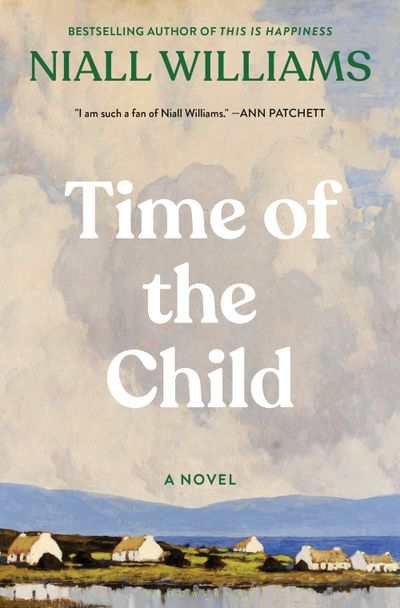Book review: ‘Time of the Child’ by Niall Williams is a holiday miracle

Just as I was feeling sated from all the rich literary Guinness, along comes another Irish writer with a lip-smacking pint. Set in an impoverished County Clare village during December 1962, but narrated from an indeterminate point in the future, Niall Williams’s “Time of the Child” dazzles as both Christmas tale and erudite novel. Why should the holiday belong to Richard Paul Evans and the Hallmark Channel?
Mired amid bogs and marshes, Faha’s a touchstone for its citizens and farmers who till the land nearby, hosting seasonal fairs where vendors sell livestock and knitted caps and bartenders pour whiskey. In his late 50s, widower Jack Troy does double duty as physician and sage, practicing medicine from his house, Avalon, attended by his bookish daughter, Ronnie. (His other grown daughters have moved away.) “Like all household arrangements, it was made up as they went along,” Williams opines, “and like all such escaped the judgement of right and wrong by the oldest alibi, family.” Dr. Troy’s authority is quiet but unquestioned: “In winter he wore what Faha called his German coat, gunmetal grey to the shins, broad wings of lapels, and the strip of dark fur on the inside of the collar. A compact man, it lent him a commander’s air.” He’s a bulwark of reason against the town’s gales of faith and fairy legends, and Williams plays with the friction between science and religion in surprising ways.
The author’s affection for his characters buoys each chapter. The people of Faha converse in their native tongue, listen raptly to Radio Éireann, pore over the Irish Independent, hang photographs of President John F. Kennedy in their parlors, and navigate personal travails with rosary beads at the ready. The doctor missed out on a chance at love and vows to reunite Ronnie with her former suitor, Noel Crowe, who has immigrated to New York. A fan of Edna O’Brien’s “The Country Girl,” Ronnie’s a prolific reader and closet scribbler, who, we’re assured, will go on to a famous career after her father’s death. (She may be a stand-in for Williams himself.) As preparations for the Christmas fair unfold, Father Tom at St. Cecelia’s founders on the shoals of dementia, provoking a clerical crisis. The identical Talty twins, known collectively as Tim-Tom, watch over their neighbors. Williams eschews spareness for an earthy lyricism; in the hour before dawn the Quinlan clan herd yearling calves to market: “Out of their dreaming, the animals started. The young took off in haunch-kicks and leaps, flying muck and puddle in a bucking charge without aim or direction other than to get away down the dark. The cows trotted, their elders’ quickstep slowed by the swaying burden of slack udders.”
As the fair closes, 12-year-old Jude Quinlan discovers a newborn girl near a cemetery gate. The Taltys haul him and the bundle onto their tractor, and they hurry to Avalon, where Dr. Troy revives the infant and passes her to his daughter, swearing the boy and Tim-Tom to secrecy. Williams’s sentences are dense but lit with the candle-glow of parable. “The small noises of the night’s breathing, wind in tree and bush, water of sky and river moving, suddenly seemed to Ronnie things of cold indifference, as though the world had no compassion left,” he writes. “She could not hear the rain against the windowpane and not think of the baby lying in it, and the thought of that filled her not only with grief but with fury … It came and made rigid her spine, it brought heat to her throat and chill to the back of her neck.”
“Time of the Child” is a stylistic cousin to the vernacular achievements of Kevin Barry and Roddy Doyle, but also distinctive: Williams draws on idiosyncrasies of speech but with an eye on literary gloss. This book is far more than an exploration of quotidian lives. As the Troys ponder the mystery of the foundling, Williams embraces grander themes, from the flaws and foibles of community to the moral obligations, if any, we have to one other. The conceit of the child who transforms the world is older than Jesus in the manger and yet as contemporary as Baby Yoda in “The Mandalorian” or the Christ-like infant in Arundhati Roy’s superb 2017 novel, “The Ministry of Utmost Happiness.”
Williams roves among his cast like a choreographer staging “The Nutcracker,” emphasizing elegant posture and steps, gestures of intimacy and alienation. His most tender scenes pair Dr. Troy and Ronnie, who realize their futures are irrevocably changed. As rumor of the baby spreads like a brushfire across Faha, Dr. Troy spirals downward, driving to cliffs that shear into the Atlantic, seeking celestial guidance from the dead woman he’d adored. The wall between clinician and man collapses. What he finds, though, is not void or silence but a transcendence – “Here was an edge, an end of country, an open sea, and a sky so enormous that into it you could send your soul” – recalling the final stanza of Philip Larkin’s poem “High Windows.”
“Time of the Child” swathes its narrative with red bulbs and silver tinsel, allusions to the Nativity, yet somehow refutes sentimentality. Williams packs his paragraphs with lush imagery and piercing psychological insight. Line by line, it may be the most beautifully written novel I’ve read this year. Let’s raise a glass of mulled wine to an Emerald Isle master at the peak of his powers.
Hamilton Cain is a book critic and the author of “This Boy’s Faith: Notes from a Southern Baptist Upbringing.” He lives in Brooklyn.